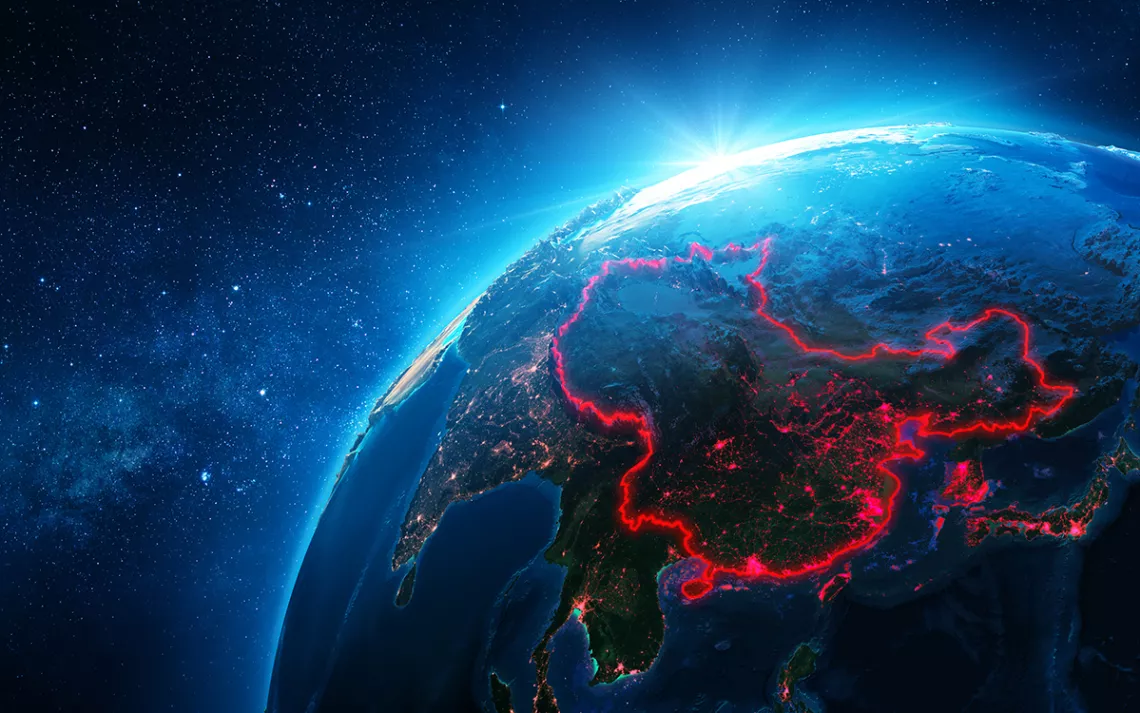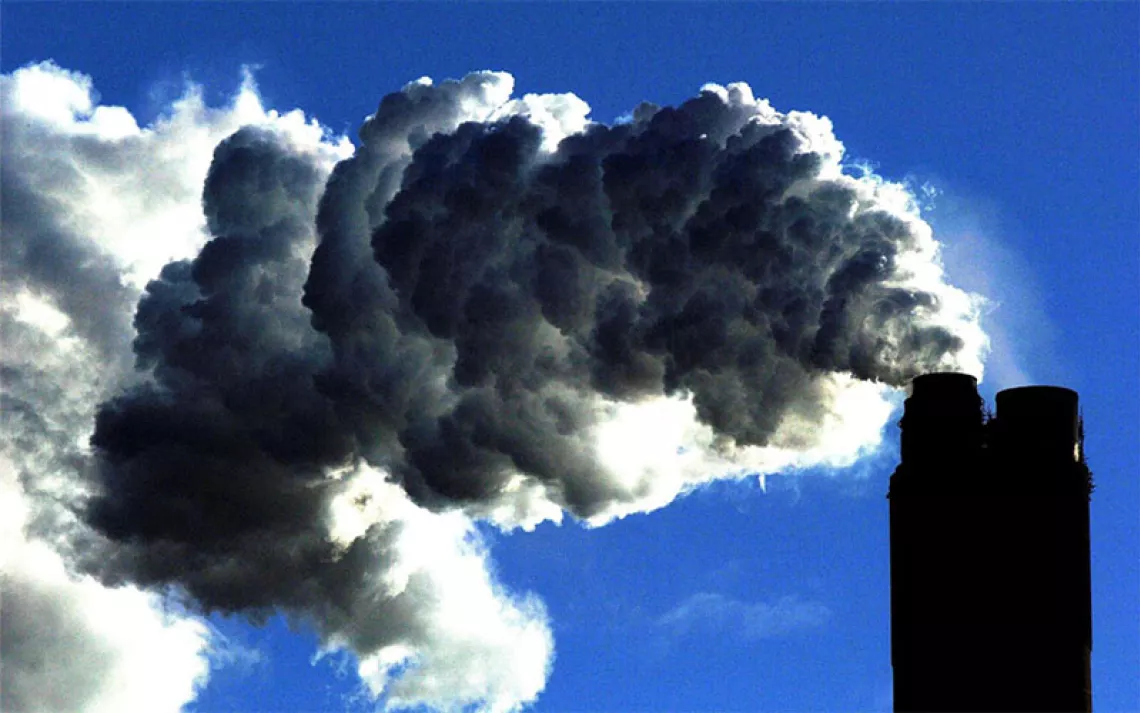Is China Ready to Commit to a Green Energy Future?
The economic behemoth brings a mix of strengths and weaknesses to COP26

Photo by RomoloTavani/iStock
As COP26 approaches, many Americans are focused on what cards the Biden administration will have to play as it negotiates with other countries to limit global greenhouse gas emissions. If Democrats in Congress manage to pass robust Build Back Better legislation, it will strengthen the administration’s position.
But another major player will be seated at the COP26 table: China. The country leads the world with about 30 percent of global carbon emissions, almost double those of the US. And those emissions are rising to record heights, just as China heads into COP26. Americans may be watching the Biden administration’s maneuverings, but as the International Energy Agency makes clear, “there is no plausible path to limiting global temperature rise to 1.5°C without China.”
So, going into COP26, it is essential to understand what cards China will bring to the table. What are the country’s goals at this critically important gathering?
The answer, it turns out, is complicated.
China has spent the better part of the past decade galloping ahead of the rest of the world in its efforts to green its economy. The results are stunning. In 2020, China brought online more new wind power than the rest of the world combined. The country is the leader in solar energy production, generating three times more power from the sun than the next closest nation. China already generates double the hydropower of Brazil, the country in second place. And the country leads the world in EV battery technology and vehicle sales; 50 percent of all EVs are bought and sold in China.
There is a simple reason why China continues to successfully scale up its energy transition: The ruling party is convinced that building the "Chinese Dream" is based on green development that will give China a 21st-century economic edge and increase the country’s global position and power.
However, despite the progress that has been made, China’s transition is rife with tensions, and several huge challenges could force it off the rails.
First, the country currently depends on coal for about 58 percent of its total energy needs (compared with the US, at 19 percent). China already runs half of all coal power plants in the world, and many more are on the domestic drawing board. This deep dependence on coal is China’s Achilles' heel, and the question everyone is going to ask at COP26 will be, How soon can China draw this dependence down?
Second, China’s demand for power is great, and will become greater. China surpassed the US in electricity production in 2010 and today produces two times more electric power than we do. Much of this is used for building the infrastructural core of the country—roads, subways, airports, and apartments. The rest feeds into factories that make many of the goods that our globalized world has come to depend on. When we purchase a plastic toy for a child’s birthday or upgrade to the latest iPhone, China’s greenhouse gas emissions come along for the ride.
In other words, when it comes to transitioning to the clean energy future, China is somehow both well ahead and far behind the rest of the world. The sheer scale of the country is at the root of this paradox. Most Americans know that China has the largest human population on the planet, but it can be hard to wrap your brain around what that means. Here’s an exercise I like to recommend: Multiply your town’s current population size by four, which is the ratio differential between the two countries’ populations. This provides "China-scale" to your home ground. When I do this math, my small city in Washington State becomes bigger than New Orleans, Seattle dwarfs Chicago, and the population of New York City surpasses the entire state of Texas.
Despite being an economic behemoth, China remains a middle-income country with per-capita earnings on par with Panama and Bulgaria. Like any other growing nation, China cannot simply cease to develop; "de-growth"’ is not on the table.
Furthermore, social inequities abound in China. Personal income is dramatically skewed toward the 60 percent of people living in cities; rural folks make about US$3,000 a year, only a third as much as urban dwellers and 20 times less than the American average. And there are 540 million Chinese people who are aiming for a middle-class life. Meanwhile, China lacks a strong social safety net. Right now, Beijing is grappling with how to manage losing 3 million jobs in the fossil fuels industry given the push toward a greener future. Retraining? 60 percent of these workers have no high school education, and more than half are over 50 years old.
Despite these many challenges, the Chinese government does have a plan to get to a net-zero future. Back in 2019, to navigate its energy transformation, the government enlisted climate researchers from Tsinghua University, MIT, and the top state planning body, the National Development and Reform Commission. The question for these experts was straightforward: “What will it take for China to reach net-zero by 2060?”
Despite some differences, the scientists agreed on an “all of the above” approach. This means dramatically ramping up all forms of non-fossil-fuel energy—solar, wind, and hydropower. More record-shattering rates of green energy growth are in the pipeline. China is also betting on a huge increase in nuclear power. Eighty new plants are due to be up and running by 2025.
Even with this “all of the above” strategy, the research groups agree that China will likely still be burning enough coal in 2050 to account for 12 to 18 percent of its power demand. This means that China (like most countries) is hedging its net-zero future on expensive, unproven technologies (see carbon capture and storage) that will allow ongoing burning of fossil fuels and yet somehow keep carbon out of the atmosphere.
China’s rocky road to COP26
China’s emissions-reduction master plan may be oriented out to 30 or 40 years from now, but the slippery thing about reducing carbon emissions is that success in the future is predicated on actions taken today. And this past year leading up to COP26 has been anything but easy for China.
Things began well enough—in September 2020, President Xi Jinping surprised the world by announcing that China would strengthen its carbon-emissions-reduction goals. Xi pledged to peak emissions before 2030 and cut them to net-zero by 2060, though he did not reveal the details of how the country would accomplish this.
Then, just a month ago, Xi unleashed more major news—China would abandon its role as the number one international financier of coal-fired power plants. This move will save plenty of carbon emissions; China has already funded 100GW (gigawatts) of these plants and has another 40GW under construction or in planning. (One GW provides power for some 750,000 homes.)
Energy experts immediately saw this announcement as a boon; with no more international coal plants financed by China, nations may have no choice but to speed up the development of renewable energy. But, again, Xi revealed few details about this new policy and had nothing to say about the fleet of new coal plants the government is constructing in China.
Meanwhile, a severe summer drought in Yunnan Province, the heartland of China’s hydropower facilities, reduced energy contributions to China’s grid by 9 percent. This put pressure on the system since throughout 2021, factories had amped up electricity demand to satisfy post-COVID desires for global goods. And cement and steel mills, China’s biggest emission hogs, continued to crank out product in response to government directives to feed a domestic construction boom.
Paradoxically, Beijing also applied pressure on power-hungry provincial authorities to cut back on dirty energy production so that China’s current climate targets would be met leading up to COP26.
The stage was set. A few weeks ago, burgeoning global demand for coal pushed international prices to 10-year highs, and China found it difficult to buy enough black gold to feed its coal plants. Then, early autumn floods in China’s main mining districts shut off supplies, and the domestic price of coal went up a record 19 percent in two days.
Power blackouts and factory shutdowns followed across much of the country, cratering the country’s energy policy, at least for the short term.
Now, Beijing has issued edicts that require coal to be bought and burned at any cost. And any timetable for peak carbon emissions has been put on hold with Premier Li Kejiang stating that economic development “holds the key to solving all of (China’s) problems.”
The present power crisis may be averted, but it is difficult to position yourself as a global leader on climate when you are making a run on the house for coal and your greenhouses gases are spiking through the roof.
What to expect from China in Glasgow
The country’s incredible gains in green energy are simply not enough to overcome increasing instabilities caused by its ongoing dependence on coal, the sheer scale of its needs, the drive to develop, extreme weather, and its over-reliance on experimental technologies. What does this mean for COP26? Here are five takeaways to guide China-watchers through the thicket of the upcoming conference:
1. China’s two major goals at COP26 derive from the playbook Beijing has been using for years. The first goal is to continue to lean on its special status as a still-developing country to buy more time to remain flexible on any solid commitments to peak emissions before 2030. This will be challenging; a month ago, Xi spoke of 2030 timing and now China wants to delay due to its recent power meltdown.
China’s second goal will be to increase its standing as the leader of the developing world as many countries fight to gain funding to implement their own climate pledges. Beijing will attempt to ensure that Washington looks less leader-like than China; this should be easy to do given recent climate policy flip-flops between the Biden and Trump administrations. On the other hand, the world’s largest emitter of greenhouses gases has missed every deadline to share the specifics of its COP26 commitments over the past two years.
2. Related to China’s two goals are the tremendous inequities within and across countries when it comes to energy production and consumption. Addressing social inequity is a big deal in the US, less so in China, and hardly on the radar screen for a majority of other top emitter nations. Yet, China and the developing world have a serious beef with the US since we have led the world by far in carbon emissions released per person since the Industrial Revolution began. And we continue to resist paying our dues. Watch what happens at COP26 around the ultimate income redistribution issue—how much money is the wealthy world willing to share with developing countries to help them reduce their emissions, knowing that these countries will never be able to pay for this by themselves?
China is one of the few deep-pocket nations that could shell out billions to address this question. It also leads the world in subsidizing fossil fuels and could transfer these funds into monies to support the global climate transition. But, instead, China is more likely to play off its recent position as a below-middle-income country and posture over how little the US and the rest of the West are willing to put on the table.
3. Keeping global temperature rise below 2°C is not just about leaving fossil fuels in the ground and substituting green energy on the supply side. The climate transition is also about reducing demands that create the need for more energy of any kind. As the CEO of BP acknowledges, “Just … correcting a supply-side issue without affecting demand will not result in a more stable system.”
But Beijing is not about to tell Chinese people to consume less. In fact, China is trying to stimulate domestic demand in an effort to broker a long-term move away from its export economy. Meanwhile, most countries, including the US, are busy attempting to rekindle their post-COVID economies. There is no telling how long China and the rest of the world will continue to pretend that every person on Earth can live at the level of a citizen of Luxembourg or Switzerland. My household of two doesn’t have the carbon footprint of BP or China, but we can eat less meat, parcel out travel, and watch what the heavy hitters do about demand in Glasgow. My prediction—very little.
4. Then there are greenhouse gases and geopolitics. China and the US together account for about 43 percent of all emissions, but the politics between the two countries is increasingly unstable. There are still avenues to work together—bolstering climate transition technologies like carbon capture and storage; co-designing an efficient UN-based climate funding mechanism to funnel monies to developing nations; tackling the need to retool global infrastructure (power grids!) to facilitate delivery of green energy. At COP26, there may be opportunities to turn growing great power competition into cooperation.
5. Lastly, remember that volatility is the new normal and the outbound ride from COP26 is going to get more combustible. China remains a special passenger on this ride. Few times in history has a country crowded center stage so rapidly, bringing so much size, challenging politics, and a chance to reframe the world. Whatever happens in China—or the US, or India, or the EU—doesn’t stay in China, or anywhere.
We are all in this together.
 The Magazine of The Sierra Club
The Magazine of The Sierra Club







